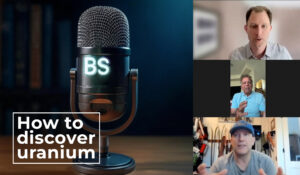- lithium demand predicted to increase fivefold by 2030
- Argentina, Bolivia and Chile account for 56% of the global lithium reserves
- Chile is second-largest producer of mined lithium, Argentina’s production forecast to rise x9 to 57,000 tons, making it third-largest global producer by 2030
Subscribe for Investment Insights. Stay Ahead.
Investment market and industry insights delivered to you in real-time.
Global lithium production will need to increase over x5 by 2030 to meet global net-zero targets — which will need an investment of over US$116 billion, according to Benchmark Source.
The largest known lithium reserves, to help meet this unprecedented demand, are in the “Lithium Triangle” — Argentina, Bolivia, Chile — which already supplies 35% of the world’s lithium.
Historically, investors have been cautious due to the operational, regulatory and environmental risks of the region. Could this be about to change?
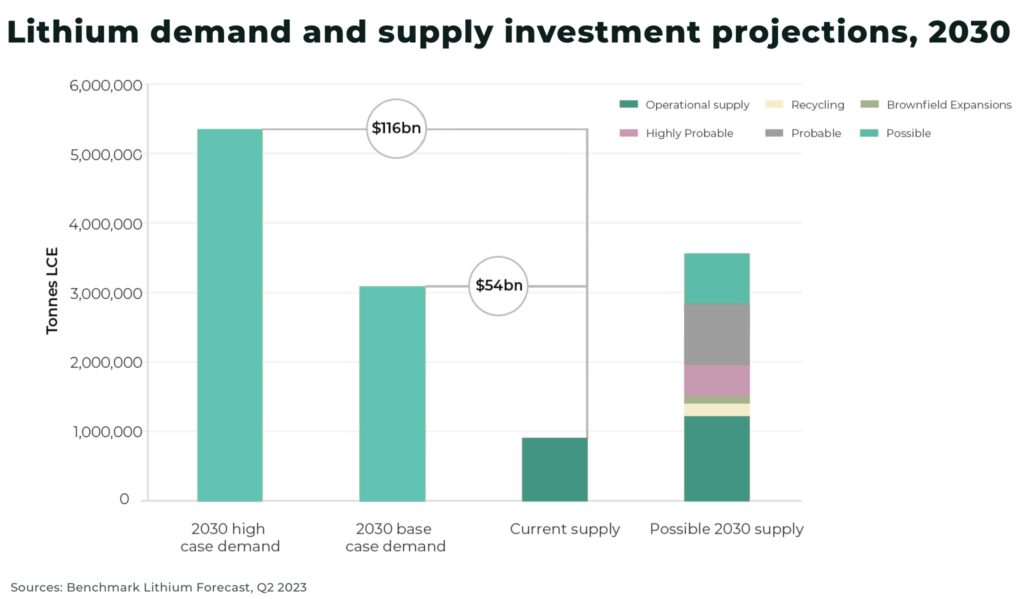
“Latin America is front and center in the race for minerals. It has just about every single mineral you need to power… the green infrastructure that we’re going to need”
— Ryan Berg, director of the Americas Program at the Center for Strategic and International Studies
Lithium demand
Demand for lithium is driven by lithium-ion electric batteries, which are expected to dominate the electric battery market, essential for the energy transition and electrification of the global energy system, for the next decade. In particular, electric vehicles but also batteries for energy storage for wind and solar power.
The “Lithium Triangle”
The salt flats across the borders of Argentina, Bolivia and Chile form a “triangle” encompassing 56% of of the world’s lithium reserves.
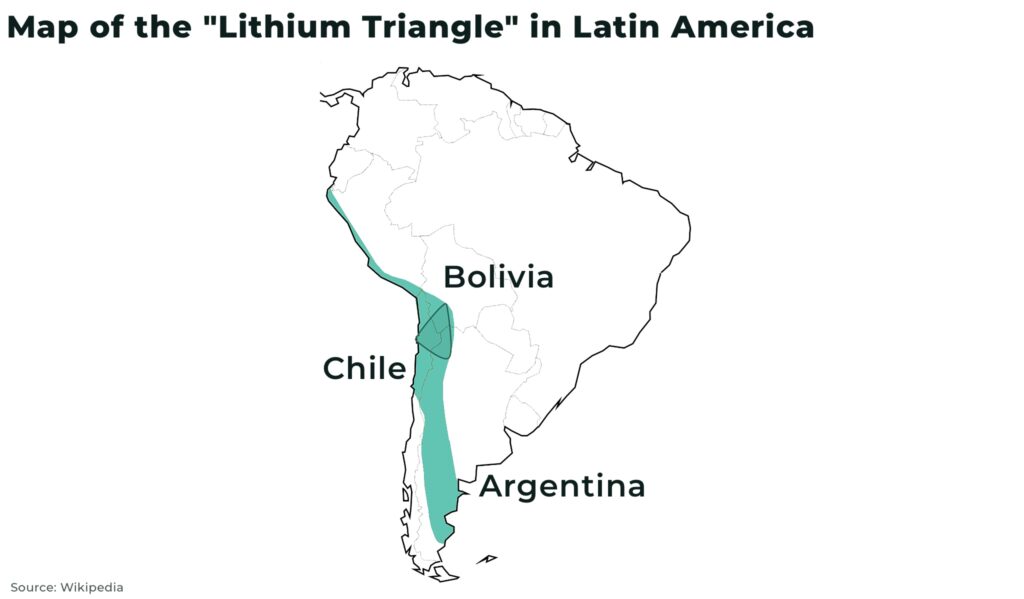
In particular, the lithium sourced from the region is predominantly lithium carbonate, produced through brine extraction (using evaporation ponds to separate the lithium, pumped up from beneath the salt flats, from other minerals) which produces fewer carbon emissions than mining from rock.
The region’s investment in lithium exploration has doubled over the last ten years, from US$44 million in 2010 to US$91 million in 2021.
Subscribe for Investment Insights. Stay Ahead.
Investment market and industry insights delivered to you in real-time.
Risky potential
There are significant — and diverse — moves by national governments and local communities in how to approach the region’s lithium potential, so how should investors interested in lithium approach the region.
Firstly, it should be noted, the regulatory and political landscape varies across and within countries in Latin America, with each country offering its own unique challenges and potential for investors, including:
Bolivia
Bolivia’s salt flats have an estimated 21 million tons of lithium, more than any other country in the world, and yet it produced just 1% of global supply in 2021.
The government wants to make lithium-ion batteries locally by 2025 — an ambitious goal — and has invested hundreds of millions of dollars into the sector.
The challenges to increasing production include:
- lack of infrastructure and challenge of extraction at high altitude, with a rainy season of several months
- a significant amount of impurities extracted lithium, especially concentrations of magnesium (the US Geological survey lists none of the reserves as commercially viable)
- local opposition to mining
The indigenous people revere Salar de Uyuni, the location of Bolivia’s vast lithium deposits. Government plans to develop the region faces ongoing opposition from local communities, for example, in 2019, a lithium deal with a German company led to protests across the country.
Now, the government is again looking to foreign companies. In June 2023, it announced lithium agreements with Russian state nuclear firm Rosatom and China’s Citic Guoan Group. This follows a similar agreement in January with Chinese battery giant CATL. In June, CATL cemented this deal by confirming a US$1.4 billion investment to develop Bolivia’s lithium reserves.
Chile
Chile is the world’s second largest producer of mined lithium (after Australia), extracting about 39,000 tons in 2022, approx 30% of the world’s mined lithium. Exports of lithium carbonate reached almost US$7.8 billion in 2021 (an increase of 777%). It also has the world’s third largest lithium reserves, at around 9.6 million tons.
In April 2023, the Boric administration announced plans to form a state-owned company for lithium, as already exists in Chile’s copper industry. This would include the nationalization of SQM and Albemarle operations, the only two companies licensed to produce lithium in Chile. The new strategy is designed to expand production through partnerships between the new state-owned lithium company and private investors.
On a recent call with more than 400 lithium industry representatives from 30 countries, Chile’s economy Minister Nicolas Grau, reportedly said the government is “close” to specifying which salt flats will be protected and which will be available for exploitation. Lithium exploration and production will be restricted to 30% of the surface area of salt flats in the country’s northern desert, leaving more than 10 open for development under new contracts.
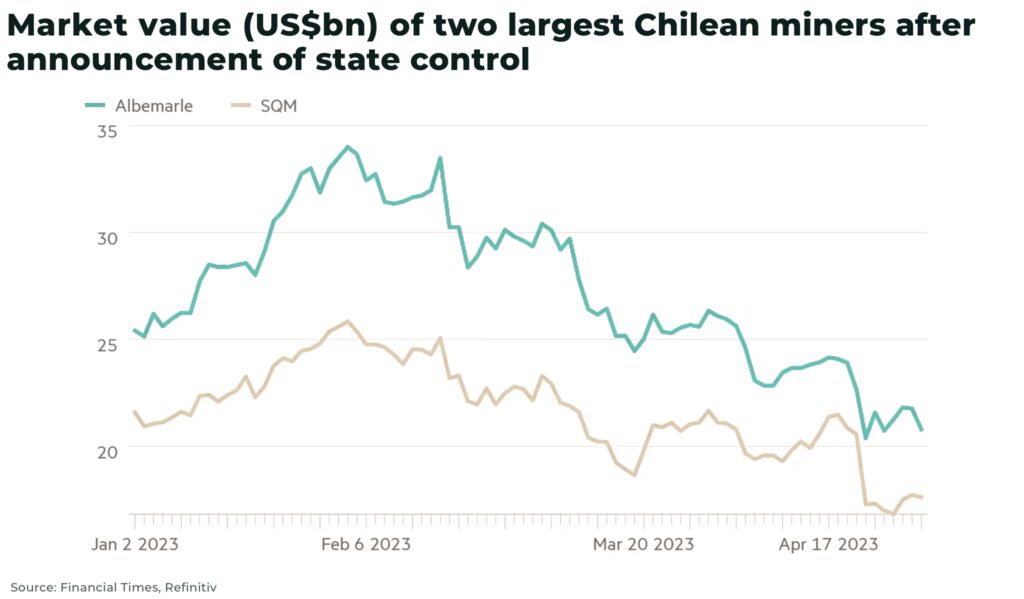
Subscribe for Investment Insights. Stay Ahead.
Investment market and industry insights delivered to you in real-time.
Lithium extraction takes place in Chile’s Atacama Desert, exacerbating water stress in what is the driest place on earth other than the poles. Manufacturing one ton of lithium carbonate requires about 600,000 liters of water, making water management a focus not only for miners, but for environmental activists and local communities.
For example, in 2021, the Chilean government approved the Minera Salar Blanco project in Salar de Maricunga in the north of the country, but local opposition led to an appeals process, which delayed the start of any mining (it has now been approved).
However, it’s worth noting, the mining industry accounts for just 4% of Chile’s industrial water consumption and is well within the flow rate of up to 240 liters per second that the Chilean authorities allow.
Argentina
Argentina holds the world’s second largest lithium reserves, with 19.3 million tons (over 20%) of global supply and has the world’s largest lithium project pipeline. Unlike Chile, Argentina has no restrictions concerning foreign investment and ownership of companies in the exploration and extraction of mineral resources — and has signaled no intention to nationalize the industry.
“Argentina is currently the second-largest in terms of lithium reserves, but we are only the fourth-largest in output. A lot of work has been done in the past 10 years and much more needs to be done [in future]”
— Franco Mignacco, president of Argentina’s Chamber of Mining Companies (CAEM) said on August 9 in Salta
Research by FastMarkets forecasts that, by 2029, Argentina will be the world’s third-largest lithium producer behind China and Australia, while Chile will have fallen to fourth place.
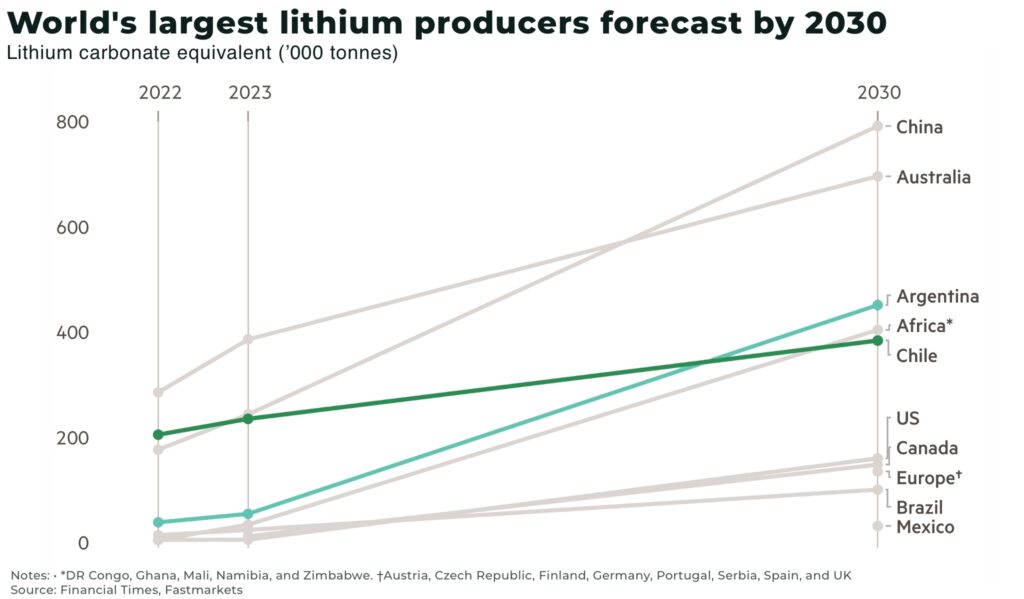
The country has a pro-market model and is home to over 30 mining projects, largely driven by private investments and regular permit approvals as the government looks to bring in more US dollars through mining exports. Major operating lithium mines include Salar Del Hombre Muerto Mine and Salar De Olaroz Lithium Project.
However, water stress is also affecting local communities in Argentina. Protesters have been regularly blocking roads to lithium mines in Jujuy since June, following reforms to the province’s constitution that would increase lithium mining in the region.
US vs China
China is expanding its economic influence in Latin America. Between 2019 and 2022, Chinese companies invested around US$4.5 billion in lithium projects in Mexico and Latin America.
For example, China’s Ganfeng Lithium is the majority stakeholder in Argentina’s US$979 million Cauchari-Olaroz operation, which is expected to produce 40,000 tons of battery-grade lithium carbonate over the next 40 years. In Chile, China’s Tianqi Lithium became the second largest shareholder in SQM, holding 23.8% of shares, and Tsingshan plans $233m investment in Chilean lithium plant.
These trade links have the US concerned as they work to secure their critical mineral supply chains, and have the potential to be used by regional governments as leverage for cooperation and investment.
Referring to growing links with China in the region, State Department Undersecretary Jose Fernandez said in July 2023, “This is a perfect example of why we need to get more involved, and why we’ve created the Minerals Security Partnership,” an effort among 14 countries and the European Union to collaborate on critical minerals production and processing.
There is an opportunity for the US to use its free trade agreement with Chile, in place since 2004, to secure adequate and sustainable lithium supplies. In particular, the US$400 billion Inflation Reduction Act in 2022 and the Defense Production Act support the production and processing of minerals and materials used for EV batteries (namely lithium, nickel, cobalt, graphite and manganese) and allow countries and companies to claim tax credits on development of mining projects from domestic or allied jurisdictions.
Subscribe for Investment Insights. Stay Ahead.
Investment market and industry insights delivered to you in real-time.
A lithium OPEC
The lithium trio (Chile, Argentina, Bolivia) have been discussing a strategic regional alliance, a kind of lithium “OPEC cartel” since July 2022, when ministers met at the Community of Latin America and Caribbean States (CELAC) conference in Buenos Aires.
While a successful commodity cartel may be appealing to the three nations, allowing them to pool their collective bargaining power to get the best deal, it is a move fraught with risk — and, therefore, we think, unlikely.
Reasons include:
- firstly, lithium is traded like a specialist product not a major commodity, making it harder to create a standardized price
- there is a small window of opportunity for Latin America to influence the global lithium market as its share of global production is expected to shrink in the future
- higher lithium prices will make it viable for other countries to develop deposits that have been too expensive to access
- interest in lithium deposits found in hard-rock formations in Australia and China is rapidly expanding
- the prospect of a lithium OPEC, along with more nationalization of mining in Chile, could make the region a top risk for foreign investors
- and, as we have highlighted, Bolivia has yet to produce lithium in any commercial quantity
So, while a lithium cartel could reinforce the region’s position, it will face great competition from other lithium-producing countries.
“As in any jurisdiction, successful mining investment in Latin America depends on two things: resilience not to get spooked by newspaper headlines, and the capacity to weed out bad projects and focus on those with a sustainable license to operate in structurally sound jurisdictions. Our message to investors is, if you recognize yourself in this description, Latin America should then be a focus of your attention”
Dr Remi Piet, leading management consultancy Embellie Advisory
What this means for investors
We believe that Latin America has a significant role to play in the development of global lithium supply chains – with significant upside.
But anticipated delays, including social, environmental and political challenges, will mean the region is unlikely to meet it’s full potential and will allow lithium-producing projects elsewhere in the world to fill the demand, especially in the short to medium term.
For investors looking for exposure to Latin America’s lithium, despite the anticipated challenges, we suggest:
- some of the major mining companies like Albemarle and Livent Corp, which offer bigger regional investments and less risk, but likely lower returns
- junior mining stocks offer more risk but potentially more upside. When looking at which junior mining stocks to consider, it will be important to do your research, and we would suggest a particular focus on location, environmental challenges and the socio-political situation in the country
In particular, Argentina’s mining-friendly policies and regulatory framework currently make it the most attractive environment in the region for foreign investment.
Subscribe for Investment Insights. Stay Ahead.
Investment market and industry insights delivered to you in real-time.









